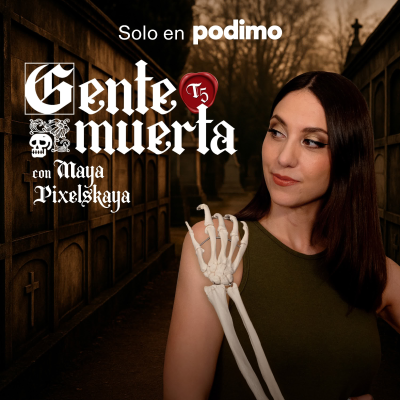
How dangerous is it…REALLY?
inglés
Tecnología y ciencia
Disfruta 30 días gratis
4,99 € / mes después de la prueba.Cancela cuando quieras.
- 20 horas de audiolibros / mes
- Podcasts solo en Podimo
- Podcast gratuitos
Acerca de How dangerous is it…REALLY?
We discuss the science of the world’s most dangerous things in 15 minutes or less
Todos los episodios
28 episodiosArsenic: Who eats old lace anyway? (E22)
Everyone knows arsenic is bad for you. Today we discuss where arsenic comes from, its history as a medicine, how much is bad for you, and how it got its awful reputation. Welcome back, everyone. I hope you are all weathering the Coronavirus pandemic well. I'm sure the world will survive this pandemic like it has the others, but individually I hope you all stay safe and healthy. Today’s topic is Arsenic: who eats old lace anyway? Arsenic as a medicine As the world searches for a cure to the Coronavirus, could I make a suggestion? Let’s not try arsenic. Through the centuries, it seems that arsenic has been advertised as a cure for many major illnesses. Since Hippocrates first recommended arsenic as a cure for ulcers and abscesses, it seems that arsenic was recommended for about every conceivable illness. It has been used to “cure” skin conditions, stomatitis, gingivitis in infants, asthma, rheumatism, hemorrhoids, cough, a fever reducer, and an all-around great health tonic. https://onlinelibrary.wiley.com/doi/full/10.1111/j.1365-2141.2009.07623.x From 1910 till the introduction of penicillin, an arsenic derivative known as Salvarsan was the primary cure for syphilis, and indications are that it actually did a pretty good job of killing the bacteria without killing the patient, something that not all syphilis cures could claim. https://www.sciencehistory.org/distillations/magazine/early-solution Today, arsenic trioxide is used to treat lymphoma and leukemia. https://pmj.bmj.com/content/79/933/391 However, arsenic is most famous as a cure for rich relatives who were too stubborn to exit this world and leave behind a well-earned birthright. A little sprinkle of some inheritance powder and suddenly the money started to flow again. Arsenic is a metalloid element with an atomic number of 33. While it can be naturally found as a pure element, it is often found bonded with sulfur or oxygen. Mankind has known about arsenic since before the Egyptians used it to embalm their dead to preserve the bodies until heat and moisture could prevent natural decay. Arsenic in groundwater The most common natural way to encounter arsenic is through contaminated groundwater. While occasionally human activity is responsible for the presence of arsenic in water, generally most contaminated wells are a result of the leaching of naturally occurring arsenic. As a child, I remember having our well tested several times to determine arsenic levels. The areas most affected by natural arsenic in the US are the southwest, northwest, northeast, and Alaska. Arsenic in groundwater can be a hazard because dangerous levels of arsenic don’t affect the taste of drinking water. Generally, the only way to detect these levels is through laboratory testing. The EPA limit for arsenic in groundwater is 10ppb. They also estimate that 2% of water supplies exceed 20ppb. 2ppb is a normal level, but levels of up to 1000 ppb have been found in drinking water. https://www.atsdr.cdc.gov/csem/csem.asp?csem=1&po=7
Radon: The monster in the basement (E21)
In today's podcast we answer a listener's question about the dangers of radon. What do you need to do to protect your family from this monster in the basement? Hello everyone. Thanks for tuning in to another podcast. I appreciate all of you taking time out of your day to listen. As always, I’d love to hear from you if you have a topic you would like me to discuss or suggestions for improvement. The best way to reach me is through my website sci-vs-fear.com. Before I get started with today's topic, I got some feedback on the https://sci-vs-fear.com/childbirth-theres-got-to-be-a-better-way/ from Gretchen. She included some research from the CDC that showed a large disparity in maternal mortality between black and white women. This study showed that black women had 2-5 times the maternal deaths of white women. https://www.cdc.gov/media/releases/2019/p0905-racial-ethnic-disparities-pregnancy-deaths.html Upon looking into it, there were several studies exploring the reason for the discrepancy. All of the authors acknowledged that attributing cause in cases like this is very difficult. I really appreciate Gretchen bringing this to my attention. In the 4-5 hours I have to research a topic, I am bound to miss something. The interesting thing to me is that the study I cited in the podcast was also from the CDC, and it showed white women having slightly higher maternal mortality. So, who is right? I don't know. Usually, when there is a discrepancy in data the truth lies somewhere in the middle. These studies are a good demonstration of how the sample population can change the study outcome. One study that I looked at found that some of the discrepancy is possibly due to the quality of the hospitals more likely to be used by black mothers. They found that white mothers using the same hospitals, had similar outcomes. https://www.ncbi.nlm.nih.gov/pmc/articles/PMC5915910/#R20 That would make sense since much of the improvement in mortality we saw in the 1930s was attributable to improvements in medical care. Gretchen also mentioned that in the US, maternal mortality is on the rise and higher than Europe. I too had found this during my research. Determining the factors responsible for this uptick would certainly be worth investigating. I suspect the answer is quite complex but worth pursuing. Thanks again for checking my facts and the input. For today's podcast, I got a question from Brett. "I recently had a salesman come to my house wanting to test it for radon. He said that our area has high radon levels and that my house could be poisoning my family. How dangerous is radon and am I putting my family at risk?" So, today’s topic is Radon: the monster living in the basement Well, Brett, deciding to get your house checked and potentially mitigated is a personal decision I can't make for you but there is a lot of interesting information available. The US attention to Radon began in 1984 when construction engineer Stanley Watras headed into work at the Limerick nuclear power plant in Pottstown Pennsylvania.
Flesh eating bacteria: It’s not just a flesh wound (E20)
We've all heard the stories, a simple cut rapidly turns into a life threatening infection that destroys muscle, skin, and tissue. Flesh eating bacteria, how worried should you be? Thanks for joining me again. Thanks for all of you who provided feedback on the podcast. Next week’s podcast will be a listener suggested topic. For those of you who haven’t yet suggested a topic, I would still love to hear from you. Sci-vs-fear.com Today's topic is: Flesh-eating bacteria: It's not just a flesh wound I first heard of flesh-eating bacteria as a young microbiology student. It is pretty scary stuff. It starts out as a minor scrape or cut and within a few days can result in a gruesome death. Take for instance the 2008 case of a 5-year-old Wisconsin boy. He fell off his bike and skinned his chin and bit his lip. Not an uncommon event in the life of a five-year-old. One day later, he was in the ICU fighting for his life against flesh-eating bacteria. Over the next three days, he underwent five different surgeries to remove dying and infected tissue. As his body fought the infection, his blood pressure began to drop precipitously. As the illness progressed, it became increasingly likely that he might not survive. Thanks to aggressive antibiotic therapy and surgical interventions, after a week in the hospital, his condition began to improve and eventually he recovered completely. https://www.livescience.com/19722-flesh-eating-bacteria-early-treatments.html Flesh eating bacteria: also known as necrotizing fasciitis The medical term for the disease caused by flesh-eating bacteria is “necrotizing fasciitis”. While many different organisms have caused necrotizing fasciitis, the most common bacterial cause is group A Streptococcus. This is the same organism that causes strep throat, however, the infection takes a completely different course. Flesh eating bacteria is the same organism that causes strep throat Within 24 hours of infection, the symptoms are readily apparent. The area of the cut or abrasion becomes red, warm, and swollen. There is a significant amount of pain at the site of the infection, much more than you would normally associate with a minor cut or scrape. The redness and swelling can begin to travel to other parts of the body. Other symptoms include diarrhea, nausea, fever, dizziness, weakness and intense thirst. If not treated immediately, within 3-4 days the symptoms can become much more severe. Swelling increases, often accompanied by a purplish rash. This rash can spread, then it transforms into blisters filled with a dark, foul-smelling liquid. The skin begins to discolor, flake and even peel away as it dies. If not treated aggressively death can occur in four to five days due to a drop in blood pressure, toxic shock, and organ failure. https://www.webmd.com/skin-problems-and-treatments/necrotizing-fasciitis-flesh-eating-bacteria While the most shocking cases are those who are otherwise healthy, most individuals who acquire the illness have underlying medical conditions that weaken the immune system.
Childbirth: There’s got to be a better way (E19)
Childbirth has been a constant in human history. Unfortunately, death among mothers was far from rare. We discuss how dangerous it was and how far we have left to go. Welcome, everyone. With this episode, I have over 20 podcasts under my belt. It has been a lot of fun and I appreciate all of you. I have a completely self-serving request of you. I'm trying to make my podcast better and I really need some good feedback to do so. I would like to know your favorite episode and one topic that you would love for me to discuss. Simply go to my website sci-vs-fear.com and click on the red contact button or if it is easier, email me directly at mailto:prometheusvsfear@gmail.com. Again, I’d like to know your favorite podcast so far and one topic you would like for me to discuss. Thanks again for all of your support! Today’s topic is: Childbirth: There’s got to be a better way As most of you could guess, the only direct experience I’ve had with childbirth is being born and those memories are a bit fuzzy. I have four kids and so I’ve had plenty of experience on the Dad side, but doesn’t really count. Not too long ago, we were in the hospital with our daughter, welcoming our first grandchild into the world. As I watched her struggle to bring my grandson into the world, I thought “this has to be one of the most dangerous things ever.” This episode goes out to my daughter and my wife. Today’s podcast is going to look at how dangerous childbirth is for the mother. Making it to 5 years old is a big gamble for the baby and is a topic for another podcast. US Childbirth deaths In the US, about 700 women a year die due to complications with pregnancy. https://www.cdc.gov/reproductivehealth/maternalinfanthealth/pregnancy-relatedmortality.htm For a country with the population of the US, this is a pretty low rate. Other causes of death with similar rates are slipping and tripping falls, falls from ladders, drowning in swimming pools, and freezing to death. https://injuryfacts.nsc.org/all-injuries/preventable-death-overview/odds-of-dying/data-details/ As we will discuss in a minute, it has taken a lot of hard work to get to this place. The leading causes of maternal death are cardiovascular conditions, hemorrhage, infection, embolism, cardiomyopathy, mental health conditions, and preeclampsia/eclampsia. Interestingly, the death rates were very similar for black and white women, except that deaths due to mental health conditions were noticeably absent among black women. Of these fatalities, a quarter occurred during pregnancy, 15% on the day of delivery, 18% 1-6 days postpartum, another 18% 7-42 days postpartum, and the remaining quarter 43-365 days postpartum. The fatalities can be categorized as preventable, and non-preventable. Hispanics had the lowest rate of preventable deaths at 62%, blacks at 63%, and white at 68%. I found it interesting that of the maternal deaths in this CDC study, over 65% were still preventable. https://www.cdc.gov/reproductivehealth/maternal-mortality/erase-mm/mmr-data-brief.html
Surviving pandemic flu: You can’t fight the flu with kung fu (E 18.1)
The next pandemic flu is an inevitability. The 1918 flu killed more people than WWI. Today we talk about steps you can take to protect yourself and family. Thanks for joining me for this bonus podcast. As we talked in the https://sci-vs-fear.com/the-flu-i-think-there-is-a-shot-for-that-e18/, a global flu pandemic is pretty much inevitable. Proper preparation is the vaccination for fear, and today we will discuss what you can do. Today’s episode is: Pandemic influenza: You can’t fight the flu with kung fu As we talked previously, if the next flu pandemic is like the 1918 Spanish Flu, the worldwide death toll could approach 1 million. This is despite all the medical advances that have been made since 1918. Were we prepared for the 2009 flu? The problem with the flu is that it is a constantly morphing threat. An evaluation of the 2007 pandemic flu strategy is a good illustration. When this plan was made, the assumption was that the next pandemic would be a highly pathogenic avian strain in the H5N1 family. To this end, vaccine for this family was strategically stockpiled for rapid response. Another assumption was that the virus would emerge overseas, lengthening the available response time. When the next pandemic strain emerged in 2009, it was from the H1N1 family, a swine-origin virus rather than avian. Instead of emerging overseas, the strain emerged in Mexico and rapidly spread to California. Fortunately, the strain proved to have a fairly low lethality and so the consequences of being wrong were not catastrophic. Once the strain was recognized in April production of a vaccine was immediately started. However, the vaccine wasn’t completed until October-6 months later. It wasn’t until December that enough vaccine could be produced to protect the general public. That’s 8 months to produce enough vaccine to protect the public once the strain is identified. Can't we just make a vaccine for pandemic flu? These vaccines will be central in slowing a pandemic, but remember that the efficacy of most vaccines is only ~40% and the protection begins to wane rapidly. Unless we get very lucky or better at predicting future strains, our most effective medical intervention will be unavailable for at least half a year. https://www.cdc.gov/mmwr/volumes/66/rr/rr6601a1.htm If the strain follows the 1918 model, where the first wave of the pandemic isn’t particularly lethal, this delay before the more deadly waves may be the advantage we need to get ahead of the virus. There is no telling whether the next pandemic will follow this model. I wouldn't feel comfortable waiting 6 months before I took action to protect myself. There are things we can do besides medical treatment. The CDC calls these actions Non-Pharmaceutical Interventions. Communities fight the pandemic These include both community-based and personal protective measures. Community-based interventions could include cancellation of schools, cessation of public gatherings and working from home or not at all. These measures would not be without difficulties. As we are seeing in the coronavirus outbreak,
Elige tu suscripción
Premium
20 horas de audiolibros
Podcasts solo en Podimo
Podcast gratuitos
Cancela cuando quieras
Disfruta 30 días gratis
Después 4,99 € / mes
Premium Plus
100 horas de audiolibros
Podcasts solo en Podimo
Podcast gratuitos
Cancela cuando quieras
Disfruta 30 días gratis
Después 9,99 € / mes
Disfruta 30 días gratis. 4,99 € / mes después de la prueba. Cancela cuando quieras.

































